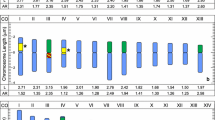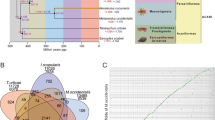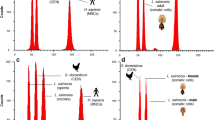Abstract
The genome size of the phytoseiid Metaseiulus (=Typhlodromus or Galendromus) occidentalis (Nesbitt) needs to be estimated before the whole nuclear genome can be sequenced. Two different procedures were used to estimate the genome size of M. occidentalis; (1) flow cytometry (Marescalchi et al. in Genome 33:789–793, 1990) and (2) quantitative real-time PCR (qRT-PCR) (Wilhelm et al. in Nucleic Acids Res 31:e56, 2003). Fluorescence intensity of propidium iodide-stained nuclei of M. occidentalis was measured by flow cytometry using females, males, and eggs. Only the eggs yielded peaks, which ranged in size from 35 to 160 Mb, with a tall peak of 140 Mb in 1-day-old eggs and 65 Mb in 2-day-old eggs, respectively. However, the peaks are broad and do not provide an accurate estimate. The qRT-PCR procedure required single-copy nuclear gene sequences from this phytoseiid. This was accomplished by designing degenerate primers, amplifying the Actin and EF1α sequences from M. occidentalis, and then designing M. occidentalis-specific primers that amplified a unique sequence. The standard qRT-PCR protocol was inefficient and amplification failed frequently, so we developed a high-fidelity qRT-PCR protocol, which utilizes a mix of two DNA polymerases (Taq and a proof-reading Tgo or ACCUZYME) to consistently amplify sequences. This allowed us to estimate the nuclear genome size of M. occidentalis as 88–90 ± 5 Mb. When compared to other arthropod genomes, this appears to be very small.


Similar content being viewed by others
References
Adams MD, Celniker SE, Holt RA et al (2000) The genome sequence of Drosophila melanogaster. Science 287:2185–2195. doi:10.1126/science.287.5461.2185
Barnes W (1994) PCR amplification of up to 35-kb DNA with high fidelity and high yield from λ bacterophage templates. Proc Natl Acad Sci USA 91:2216–2220. doi:10.1073/pnas.91.6.2216
Dearden PK, Donly C, Grbic M (2002) Expression of pair-rule homologues in a chelicerate: early patterning of the two-spotted spider mite Tetranychus urticae. Development 129:5461–5472. doi:10.1242/dev.00099
DeSalle R, Gregory TR, Johnston JS (2005) Preparation of samples for comparative studies of arthropod chromosomes: visualization, in situ hybridization, and genome size estimation. Mol Enzymol 395:460–488. doi:10.1016/S0076-6879(05)95025-8
Dolezel J, Bartos J, Voglmayr H, Greilhuber J (2003) Nuclear DNA content and genome size of trout and human. Cytochemistry 51A:127–128
Fingen-Eigen M, Domdey H, Kohrer K (1996) The ribosomal protein gene RPS3 is an essential single copy gene of the yeast Saccharomyces cerevisiae. Biochem Biophys Res Commun 223:397–403. doi:10.1006/bbrc.1996.0905
Galbraith DW, Harkins KR, Maddox JM, Ayers NM, Sharma DP, Firoozabady E (1983) Rapid flow cytometric analysis of the cell cycle in intact plant tissues. Science 220:1049–1051. doi:10.1126/science.220.4601.1049
Gao J, Scott JG (2006) Use of quantitative real-time polymerase chain reaction to estimate the size of the house-fly Musca domestica genome. Insect Mol Biol 15:835–837. doi:10.1111/j.1365-2583.2006.00690.x
Geraci NS, Johnston JS, Robinson P, Wikel SK, Hill CA (2007) Variation in genome size of argasid and ixodid ticks. Insect Biochem Mol Biol 37:399–408. doi:10.1016/j.ibmb.2006.12.007
Goldberg RB, Crain WR, Ruderman JV, Moore GP, Barnett TR, Higgins RC, Gelfand RA, Galau GA, Britten RJ, Davidson EH (1975) DNA sequence organization in genomes of five marine invertebrates. Chromosoma 51:225–251. doi:10.1007/BF00284817
Grbic M, Khila A, Lee K-Z, Bjelica A, Grbic V, Whistlecraft J, Verdon L, Navajas M, Nagy L (2007) Mity model: Tetranychus urticae, a candidate chelicerate model organism. Bioessays 29:489–496. doi:10.1002/bies.20564
Gregory TR, Shorthouse DP (2003) Genome sizes of spiders. J Hered 94:285–290. doi:10.1093/jhered/esg070
Guerrero FD, Nene VM, George JE, Baker SC, Willadsen P (2005) Sequencing a new target genome: The Boophilus microplus (Acari: Ixodidae) genome project. J Med Entomol 43:9–16. doi:10.1603/0022-2585(2006)043[0009:SANTGT]2.0.CO;2
Holt RA, Subramanian GM, Halpern A, Sutton GG, Charlab R, Nusskern DR et al (2002) The genome sequence of the malaria mosquito Anopheles gambiae. Science 298:129–149. doi:10.1126/science.1076181
Hoy MA (1979) Parahaploidy of the “arrhenotokous” predator, Metaseiulus occidentalis (Acarina: Phytoseiidae) demonstrated by X-irradiation of males. Entomol Exp Appl 26:97–106
Hoy MA (1984) Genetic improvement of a biological control agent: multiple pesticide resistance and nondiapause in Metaseiulus occidentalis (Nesbitt) (Phytoseiidae). In: Griffiths DA, Bowman CE (eds) Acarology VI, vol 2. Ellis Horwood, Chichester, pp 673–679
Hoy MA (1985) Recent advances in genetics and genetic improvement of the Phytoseiidae. Annu Rev Entomol 30:345–370. doi:10.1146/annurev.en.30.010185.002021
Hoy MA (2006) Perspectives on the development of genetically modified arthropod natural enemies for agricultural pest management programmes. CAB Reviews: Perspectives in Agriculture, Veterinary Science. Nutr Nat Resour 1(058):12
Hoy MA, Standow KA (1982) Inheritance of resistance to sulfur in the spider mite predator Metaseiulus occidentalis. Entomol Exp Appl 31:316–323
Hoy MA, Jeyaprakash A, Nguyen R (2001) Long PCR is a sensitive method for detecting Liberobacter asiaticum in parasitoids undergoing risk assessment in quarantine. Biol Control 22:278–287. doi:10.1006/bcon.2001.0973
Huffaker CB, Van De Vrie M, McMurtry JA (1970) Ecology of tetranychid mites and their natural enemies: a review. II. Tetranychid populations and their possible control by predators: an evaluation. Hilgardia 40:391–458
Jeyaprakash A, Hoy MA (1995) Complete sequence of a mariner transposable element from the predatory mite Metaseiulus occidentalis isolated by an inverse PCR approach. Insect Mol Biol 4:31–39. doi:10.1111/j.1365-2583.1995.tb00005.x
Jeyaprakash A, Hoy MA (2000) Long PCR improves Wolbachia DNA amplification: wsp sequences found in 76% of sixty-three arthropod species. Insect Mol Biol 9:393–405. doi:10.1046/j.1365-2583.2000.00203.x
Jeyaprakash A, Hoy MA (2004) Multiple displacement amplification in combination with high-fidelity PCR improves detection of bacteria from single females or eggs of Metaseiulus occidentalis (Nesbitt) (Acari: Phytoseiidae). J Invertebr Pathol 86:111–116. doi:10.1016/j.jip.2004.05.005
Jeyaprakash A, Hoy MA (2007) The mitochondrial genome of the predatory mite Metaseiulus occidentalis (Arthropoda: Chelicerata: Acari: Phytoseiidae) is unexpectedly large and contains several novel features. Gene 391:264–274. doi:10.1016/j.gene.2007.01.012
Johnston JS, Yoon KS, Strycharz JP, Pittendrigh BR, Clark JM (2007) Body lice and head lice (Anoplura: Pediculidae) have the smallest genomes of any hemimetabolous insect reported to date. J Med Entomol 44:1009–1012. doi:10.1603/0022-2585(2007)44[1009:BLAHLA]2.0.CO;2
Marescalchi O, Scali V, Zuccotti M (1990) Genome size in parental and hybrid species of Bacillus (Insecta, Phasmatodea) from southeastern Sicily: a flow cytometric analysis. Genome 33:789–793
Navajas M, Lagnel J, Fauvel G, De Moraes G (1999) Sequence variation of ribosomal internal transcribed spacers (ITS) in commercially important Phytoseiidae mites. Exp Appl Acarol 23:851–859. doi:10.1023/A:1006251220052
Nelson-Rees WA, Hoy MA, Roush RT (1980) Heterochromatization, chromatin elimination and haploidization in the parahaploid mite Metaseiulus occidentalis (Nesbitt) (Acarina: Phytoseiidae). Chromosoma 77:263–276. doi:10.1007/BF00286052
Nene V, Wortman JR, Lawson D et al (2007) Genome sequence of Aedes aegypti, a major arbovirus vector. Science 316:1718–1723. doi:10.1126/science.1138878
Panzera F, Ferrandis I, Ramsey J, Salazar-Schettino PM, Cabrera M, Monroy C, Bargues MD, Mas-Goma S, O’Connor JE, Angulo VM, Jaramillo N, Perez R (2007) Genome size determination in chagas disease transmitting bugs (Hemiptera-Triatominae) by flow cytometry. Am J Trop Med Hyg 76:516–521
Presnail JK, Hoy MA (1992) Stable genetic transformation of a beneficial arthropod, Metaseiulus occidentalis (Acari: Phytoseiidae), by a microinjection technique. Proc Natl Acad Sci USA 89:7732–7736. doi:10.1073/pnas.89.16.7732
Rasch EM, Connelly BA (2005) Genome size and endonuclear DNA replication in spiders. J Morphol 265:209–214. doi:10.1002/jmor.10352
Regier JC, Schultz JW (1997) Molecular phylogeny of the major arthropod groups indicates polyphyly of crustaceans and a new hypothesis for the origin of hexapods. Mol Biol Evol 14:902–913
Roush RT, Hoy MA (1981) Genetic improvement of Metaseiulus occidentalis: selection with methomyl, dimethoate, and carbaryl and genetic analysis of carbaryl resistance. J Econ Entomol 74:138–141
Sambrook J, Russell DW (2001) Molecular Cloning: A Laboratory Manual. Cold Spring Harbor Press, Cold Spring Harbor, NY
Sambrook J, Fritsch EF, Maniatis T (1989) Molecular Cloning: a Laboratory Manual, vol 2. Cold Spring Harbor Press, Cold Spring Harbor, NY
Sherman F, Fink GR, Hicks JB (1986) Laboratory Course Manual for Methods in Yeast Genetics. Cold Spring Harbor Laboratory, Cold Spring Harbor, NY
Soleimani VD, Baum BR, Johnson DA (2006) Quantification of the retrotransposan BARE-1 reveals the dynamic nature of the barley genome. Genome 49:389–396. doi:10.1139/G05-119
Tsutsui ND, Suarez AV, Spagna JC, Johnston JS (2008) The evolution of genome size in ants. BMC Evol Bio 8:64 (http://www.biomedcentral.com/1471-2148/8/64)
Ullmann AJ, Lima CMR, Guerrero FD, Piesman J, Black WC (2005) Genome size and organization in the blacklegged tick, Ixodes scapularis and the Southern cattle tick, Boophilus microplus. Insect Mol Biol 14:217–222. doi:10.1111/j.1365-2583.2005.00551.x
Wilhelm J, Pingoud A, Hahn M (2003) Real-time PCR-based method for the estimation of genome sizes. Nucleic Acids Res 31:e56
Xia QY, Zhou ZY, Lu C, Cheng DJ, Dai FY, Li B et al (2004) A draft sequence for the genome of the domesticated silkworm (Bombyx mori). Science 306:1937–1940. doi:10.1126/science.1102210
Zdobnov EM, von-Mering C, Letunic I et al (2002) Comparative genome and proteome analysis of Anopheles gambiae and Drosophila melanogaster. Science 298:149–159. doi:10.1126/science.1077061
Acknowledgments
This research was supported by the Davies, Fischer, and Eckes endowment to M. A. Hoy and the Institute of Food and Agricultural Sciences at the University of Florida.
Author information
Authors and Affiliations
Corresponding author
Rights and permissions
About this article
Cite this article
Jeyaprakash, A., Hoy, M.A. The nuclear genome of the phytoseiid Metaseiulus occidentalis (Acari: Phytoseiidae) is among the smallest known in arthropods. Exp Appl Acarol 47, 263–273 (2009). https://doi.org/10.1007/s10493-008-9227-x
Received:
Accepted:
Published:
Issue Date:
DOI: https://doi.org/10.1007/s10493-008-9227-x




